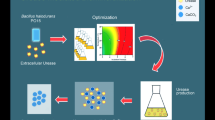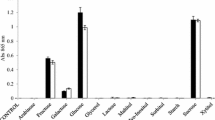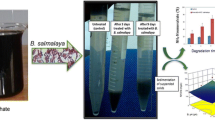Abstract
The aim of this study was to isolate thermophilic bacteria to be used in in situ bioremediation of molybdate at elevated temperatures. Two molybdate reducing bacteria (Pharon2 and Pharon3) were isolated from the hot Spring at Pharaoh's Bath, Sinai, Egypt. The isolates were identified by 16S rRNA genes sequencing and were submitted to GenBank as Bacillus tequilensis strain Pharon2 (MK078034) and Bacillus sonorensis strain Pharon3 (MK078035). The molybdenum blue production was optimized using multifactorial statistical approaches, Plackett–Burman and central composite designs. According to the results obtained by response optimizer, the maximum molybdenum blue production achieved was 1.04 and 1.12 represented as absorbance at 865 nm, with the optimum salt concentration of 1.1 and 2.5%; at pH 7.02 and 7.07; incubation temperature of 46.1 and 52.2 °C; sucrose and glucose as an electron donor for Bacillus tequilensis strain Pharon2 and Bacillus sonorensis strain Pharon3, respectively. In conclusion, the thermophilic bacterial isolates belonging to the genus Bacillus could be used in in situ bioremediation under elevated temperatures. To the best of our knowledge, this is the first record of molybdenum blue production by thermophilic Bacillus tequilensis and Bacillus sonorensis.




Similar content being viewed by others
References
Meeker JD, Rossano MG, Protas B, Diamond MP, Puscheck E, Daly D, Paneth N, Wirth JJ (2008) Cadmium, lead, and other metals in relation to semen quality: human evidence for molybdenum as a male reproductive toxicant. Environ Health Perspect 116:1473–1479
Bi CM, Zhang YL, Liu FJ, Zhou TZ, Yang ZJ, Gao SY, Wang SD, Chen XL, Zhai XW, Ma XG, Jin LJ (2013) The effect of molybdenum on the in vitro development of mouse preimplantation embryos. Syst Biol Reprod Med 59:69–73
Zhai XW, Zhang YL, Qi Q, Bai Y, Chen XL, Jin LJ, Ma XG, Shu RZ, Yang ZJ, Liu FJ (2013) Effects of molybdenum on sperm quality and testis oxidative stress. Syst Biol Reprod Med 59:251–255
Zhang YL, Liu FJ, Chen XL, Zhang ZQ, Shu RZ, Yu XL, Zhai XW, Jin LJ, Ma XG, Qi Q, Liu ZJ (2013) Dual effects of molybdenum on mouse oocyte quality and ovarian oxidative stress. Syst Biol Reprod Med 59:312–318
Kincaid RL (1980) Toxicity of ammonium molybdate added to drinking water of calves. J Dairy Sci 63:608–610
Turnlund JR, Keyes WR, Peiffer GL (1995) Molybdenum absorption, excretion, and retention studied with stable isotopes in young men at five intakes of dietary molybdenum. Am J Clin Nutr 62:790–796
Ward JD, Spears JW (1999) The effects of low-copper diets with or without supplemental molybdenum on specific immune responses of stressed cattle. Anim Sci J 77:230–237
King RB, Long GM, Sheldon JK (1992) Practical environmental bioremediation: the field guide. Lewis Publisher, Boca Raton, FL
Sabullah MK, Rahman MF, Ahmad SA, Sulaiman MR, Shukor MS, Shamaan NA, Shukor MY (2016) Isolation and characterization of a molybdenum-reducing and glyphosate-degrading Klebsiella oxytoca strain Saw-5 in soils from Sarawak. AGRIVITA 38:1–13
Neunhäuserer C, Berreck M, Insam H (2001) Remediation of soils contaminated with molybdenum using soil amendments and phytoremediation. Water Air Soil Pollut 128:85–96
Rieger PG, Meier HM, Gerle M, Vogt U, Groth T, Knackmuss HJ (2002) Xenobiotics in the environment: present and future strategies to obviate the problem of biological persistence. J Biotechnol 94:101–123
Manogaran M, Ahmad SA, Yasid NA, Yakasai HM, Shukor MY (2018) Characterisation of the simultaneous molybdenum reduction and glyphosate degradation by Burkholderia vietnamiensis AQ5-12 and Burkholderia sp. AQ5-13. J Biotech 8:117
Lim KT, Shukor MY, Wasoh H (2014) Physical, chemical, and biological methods for the removal of arsenic compounds. BioMed Res Int 2014:1–9
Shukor MY, Syed MA (2010) Microbiological reduction of hexavalent molybdenum to molybdenum blue: current research, technology and education topics in applied microbiology and microbial biotechnology. Formatex Research Center, Badajoz
Ahmad SA, Shukor MY, Shamaan NA, Mac Cormack WP, Syed MA (2013) Molybdate reduction to molybdenum blue by an Antarctic bacterium. BioMed Res Int 2013:1–10
Masdor N, Shukor MSA, Khan A, Halmi MIEB, Abdullah SRS, Shamaan NA, Shukor MY (2015) Isolation and characterization of a molybdenum-reducing and SDS degrading Klebsiella oxytoca strain Aft-7 and its bioremediation application in the environment. Biodiversitas 16:238–246
Sar P, Kazy SK, Paul D, Sarkar A (2013) Metal bioremediation by thermophilic microorganisms. In: Satyanarayana T, Littlechild J, Kawarabayasi Y (eds) Thermophilic microbes in environmental and industrial biotechnology. Springer, Dordrecht, pp 171–201
Yunus SM, Hamim HM, Anas OM, Aripin SN, Arif SM (2009) Mo(VI) reduction to molybdenum blue by Serratia marcescens strain Dr. Y 9. Polish J Microbiol 58:141–147
Saeed AM, El Shatoury E, Hadid R (2019) Production of molybdenum blue by two novel molybdate reducing bacteria belonging to the genus Raoultella isolated from Egypt and Iraq. J Appl Microbiol 126:1722–1728
Altschul SF, Thomas L, Madden AA, Schäffer ZZ, Miller W, Lipman DJ (1997) Gapped BLAST and PSI BLAST: a new generation of protein database search programs. Nucleic Acid Res 25:3389–3402
Tamura K, Stecher G, Peterson D, Filipski A, Kumar S (2013) MEGA6: molecular evolutionary genetics analysis version 6.0. Mol Biol Evol 30:2725–2729
Ghani B, Takai M, Hisham NZ, Kishimoto N, Ismail AM, Tano T, Sugio T (1993) Isolation and characterization of a Mo6+-reducing bacterium. Appl Environ Microbiol 59:1176–1180
Koshy M, De S (2019) Effect of Bacillus tequilensis SALBT crude extract with pectinase activity on demucilation of coffee beans and juice clarification. J Basic Microbiol 59:1185–1194
Li H, Guan Y, Dong Y, Zhao L, Rong S, Chen W, Lv M, Xu H, Gao X, Chen R, Li L (2018) Isolation and evaluation of endophytic Bacillus tequilensis GYLH001 with potential application for biological control of Magnaporthe oryzae. PLoS ONE 13(1–18):e0203505
Velusamy P, Pachaiappan R, Christopher M, Vaseeharan B, Anbu P, So JS (2015) Isolation and identification of a novel fibrinolytic Bacillus tequilensis CWD-67 from dumping soils enriched with poultry wastes. J Gen Appl Microbiol 61:241–247
Bhosale H, Shaheen U, Kadam T (2016) Characterization of a hyperthermostable alkaline lipase from Bacillus sonorensis 4R. Enzyme Res 2016:1–11
Azadian F, Badoei-dalfard A, Namaki-Shoushtari A, Karami Z, Hassanshahian M (2017) Production and characterization of an acido-thermophilic, organic solvent stable cellulase from Bacillus sonorensis HSC7 by conversion of lignocellulosic wastes. J Genet Eng Biotechnol 15:187–196
Oehlert GW (2000) Design and analysis of experiments: response surface design. Wiley, New York
Montgomery DC (2013) Design and analysis of experiments, 8th edn. Wiley, New York
Azhar M, Uniyal V, Chauhan N, Rawat DS (2014) Isolation & biochemical characterization of Halophiles from Sahastradhara region, Dehradrun, India. Int J Curr Microbial App Sci 3:753–760
Lim HK, Syed MA, Shukor MY (2012) Reduction of molybdate to molybdenum blue by Klebsiella sp. strain hkeem. J Basic Microbiol 52:296–305
Mohd Adnan AS, Abu Zeid IM, Ahmad SA, Halmi MIE, Abdullah SRS, Masdor NA, Shukor MS, Shukor MY (2016) A molybdenum-reducing Bacillus sp. strain Zeid 14 in soils from Sudan that could grow on amides and acetonitrile. Malaysian J Soil Sci 20:111–134
Othman AR, Bakar NA, Halmi MIE, Johari WLW, Ahmad SA, Jirangon H, Syed MA, Shukor MY (2013) Kinetics of molybdenum reduction to molybdenum blue by Bacillus sp. strain A. rzi. BioMed Res Int 2013:1–9
Mansur R, Gusmanizar N, Roslan MAH, Ahmad SA, Shukor MY (2017) Isolation and characterisation of a molybdenum-reducing and metanil yellow dye-decolourising Bacillus sp. strain Neni-10 in soils from west Sumatera, Indonesia. Trop Life Sci Res 28:69–90
Acknowledgements
The authors are greatly thankful to the Department of Microbiology, Faculty of Science, Ain Shams. University, Egypt and to Ms. Amira Gamal, Assistant lecturer at Egyptian Atomic Energy Authority for her collaboration in Statistical factorial designs.
Author information
Authors and Affiliations
Corresponding author
Ethics declarations
Conflict of interest
The authors declare that there are no conflicts of interest.
Research Involving Human and Animal Rights
This article does not contain any studies with human participants or animals performed by any of the authors.
Additional information
Publisher's Note
Springer Nature remains neutral with regard to jurisdictional claims in published maps and institutional affiliations.
Electronic supplementary material
Below is the link to the electronic supplementary material.
Rights and permissions
About this article
Cite this article
Saeed, A.M., Sayed, H.A.E. & El-Shatoury, E.H. Optimizing the Reduction of Molybdate by Two Novel Thermophilic Bacilli Isolated from Sinai, Egypt. Curr Microbiol 77, 786–794 (2020). https://doi.org/10.1007/s00284-020-01874-y
Received:
Accepted:
Published:
Issue Date:
DOI: https://doi.org/10.1007/s00284-020-01874-y




